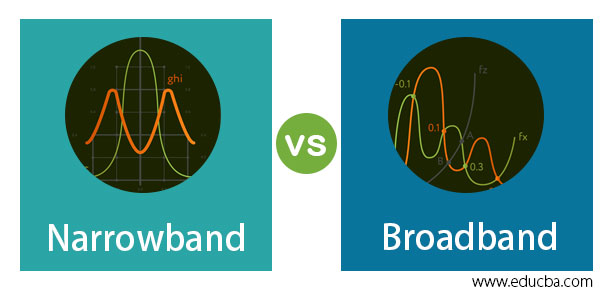Updated July 4, 2023

Difference Between Narrowband vs Broadband
The following article provides an outline for Narrowband vs Broadband. Narrowband and Broadband are used in telecommunication as tools for setting a band of frequencies and communicating in the spectrum. A narrow set of frequencies is considered in the Narrowband, and communication happens only in those frequencies. Less number of frequency sets are used as it is designed to work only with less frequencies. Broadband covers a wide bandwidth and uses different signals and frequencies in its spectrum.
Head to Head Comparison Between Narrowband vs Broadband (Infographics)
Below are the top 8 differences between Narrowband vs Broadband:
Key Difference Between Narrowband vs Broadband
Let us discuss some of the major key differences between Narrowband vs Broadband:
- The Narrowband does not cover a wide range of frequencies; hence the disturbance in the narrowband will be more. We will not face any of these issues in broadband. It covers a wide range of frequencies so that the disturbance will be less.
- There is also a negative side to the above point. The circuit is complex in broadband when compared with narrowband. This complex scenario affects efficiency and performance because it takes time to design a band of complex circuits. This results in less yield. Hence the amplifier used in broadband takes more time to draw current, resulting in low performance. And this is an advantage in narrowband. The performance and efficiency are good. Often, broadband requires more amplifier stages to meet the efficiency of narrowband.
- The power consumption required by narrowband is less when compared with broadband. Remote systems care more about the cost and reliability, and power used. Thus, broadband stands low in all these cases. Narrowband is a better option for all the systems where these three factors are a concern.
- Narrowband has more channels in the selected area of communication, and thus, many applications prefer narrowband. This has more access and reliability in the selected area. Thus, military applications, sensors, and alarm systems work well with narrowband. It has a good range as well. If the data is more in the used application, it is better to use broadband.
- This also adds to the data in the communication system. Less coding in narrowband makes it preferable for communication aspects. This becomes an added advantage in the data handled by the application.
Narrowband vs Broadband Comparison Table
Let’s discuss the top comparison between Narrowband vs Broadband:
|
Narrowband |
Broadband |
| Heavy data applications cannot be used in this band as the range is less, and the load cannot be survived within the spectrum in the small area of its application. | Criminal surveillance applications and public safety measures prefer heavy data applications due to their ability to handle large amounts of data easily. |
| As there are filters applied in the spectrum, the isolation between the channels is more, and this makes communication more secure. | The lack of applied filters in channels means they cannot offer isolation, posing a security problem for individual channels. |
| Oscillator technologies are used to improve the accuracy in frequency in narrowband. | Frequency accuracy is not a problem in this spectrum as they are accurate for the specifics applied and work well. |
| The infrastructure is good for the spectrum and always available whenever needed. It stands good when compared with broadband. | The infrastructure is improving and cannot be compared with narrowband. |
| The coverage is less, and it cannot be improved. The Narrowband is designed to work with short bandwidth in the spectrum. | The coverage of the band is more as it covers more bandwidth. It can be increased if the goal is to improve the signal integrity. |
| The range covered is long in the communication system. | The range covered is less; if we increase the range, efficiency decreases, and the spectrum covered is less. |
| Using the internet in narrowband is not a good idea as the speed will be less, and it will not work properly compared to broadband. | The Internet can be used more efficiently with broadband, and it is faster for downloads and browsing. |
| The Narrowband penetrates into the environment more and catches all the signals in the selected frequency. Thus, an entire picture of the frequency in which the narrowband is working can be known. | The frequency of the communication system always avoids other signals because broadband signals do not penetrate the environment significantly. |
Conclusion
Some applications are common for both, and it is good to select these based on their usage. But due to the advancement of technology, narrowband has developed well and can be used in many applications with less cost and high efficiency.
Recommended Articles
This is a guide to Narrowband vs Broadband. Here we discuss the Narrowband vs Broadband key differences with infographics and a comparison table. You may also have a look at the following articles to learn more –

